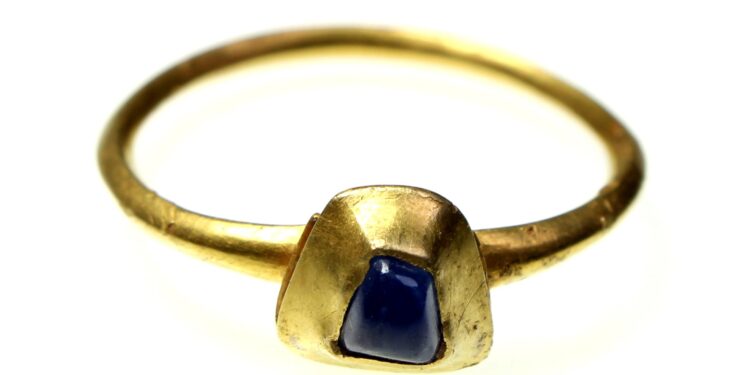Archaeologists have uncovered a remarkable medieval gold ring at a castle site in Slovakia, featuring a rare purple sapphire believed to have been imported from Sri Lanka. The discovery sheds new light on the extensive trade networks of the Middle Ages and suggests a higher level of wealth and connectivity in the region than previously understood. Experts say the gemstone’s origin highlights the far-reaching links between Europe and Asia during this period, offering fresh insights into medieval craftsmanship and commerce.
Medieval Gold Ring Discovery Sheds Light on Slovakia’s Trade Connections
Archaeologists recently uncovered a stunning medieval gold ring within the walls of a Slovakian castle, revealing an exquisite purple sapphire at its center – a gemstone traced back to Sri Lanka. This rare find highlights the extensive trade networks that flourished during the Middle Ages, connecting Central Europe with distant Asian markets. The ring’s craftsmanship, combined with the gemstone’s origin, points to the involvement of well-established merchants and the cultural exchange that transcended vast geographic boundaries.
Key insights from the discovery include:
- The purple sapphire’s provenance confirms direct or indirect trade routes between Slovakia and South Asia.
- Medieval Slovakia’s role as a trading hub for luxury goods enticed by European nobility and emerging mercantile classes.
- Innovative jewelry techniques of the period, combining local goldsmith skills with exotic materials.
| Feature | Details |
|---|---|
| Material | 22k Gold |
| Gemstone | Purple Sapphire |
| Origin of Sapphire | Sri Lanka |
| Estimated Age | 14th Century |
| Location Found | Slovak Castle Keep |
Rare Purple Sapphire Traces Ancient Gemstone Routes from Sri Lanka to Europe
The discovery of a medieval gold ring adorned with a rare purple sapphire has shed new light on the extensive trade networks connecting Sri Lanka and Europe during the Middle Ages. Analytical studies confirm that this uniquely hued gemstone originated from Sri Lanka’s famed gem mines, emphasizing the island’s critical role in supplying precious stones to far-flung European aristocracy. This find not only highlights the exceptional craftsmanship of medieval jewelers but also traces centuries-old maritime and overland routes that spanned continents, revealing a complex web of cultural and economic exchanges.
Significantly, the presence of the purple sapphire in a Slovakian castle suggests that merchants and traders favored this exotic gem for its rarity and symbolic value. Historians now posit that the gemstone likely traveled through a sequence of trade hubs, including:
- Colombo: Primary export point in Sri Lanka
- Alexandria: Major Mediterranean trading port
- Venice: Gateway to European luxury markets
- Bratislava: Final destination, home to nobility
| Trade Route Segment | Transportation Mode | Notable Historical Period |
|---|---|---|
| Sri Lanka to Alexandria | Maritime – Indian Ocean & Red Sea | 13th-15th Century |
| Alexandria to Venice | Maritime – Mediterranean Sea | 14th-16th Century |
| Venice to Bratislava | Overland – Carpathian Routes | Medieval Period |
Experts Recommend Further Archaeological Surveys to Uncover Hidden Medieval Treasures
The discovery of a medieval gold ring featuring a rare purple sapphire sourced from Sri Lanka has ignited fresh interest in the extensive archaeological potential of Slovakia’s historic castles. Experts emphasize that such finds not only illuminate medieval trade routes but also hint at the existence of undiscovered artifacts hidden beneath the layers of time. This revelation prompts archaeologists to advocate for a series of meticulously planned surveys employing modern technologies such as ground-penetrating radar (GPR) and 3D mapping to reveal what remains buried across these ancient sites.
In light of the significance of the imported sapphire, researchers suggest targeted excavations should prioritize key factors to maximize artifact recovery, including:
- Proximity to former trade routes evidenced by historical records and landscape features
- Structural anomalies detected via non-invasive imaging techniques
- Soil composition analyses to identify potential burial spots for precious metals and stones
| Survey Method | Application | Expected Benefit |
|---|---|---|
| Ground-Penetrating Radar (GPR) | Detect subsurface anomalies | Pinpoint artifact locations |
| Magnetometry | Identify buried structures | Map castle foundations |
| 3D Mapping | Create detailed site models | Plan precise excavations |
In Summary
The discovery of the medieval gold ring adorned with a rare purple sapphire imported from Sri Lanka offers a remarkable glimpse into the trade networks and craftsmanship of the period. Unearthed at a Slovakian castle, the artifact not only underscores the cultural and economic connections spanning continents but also enriches our understanding of medieval luxury and status symbols. As researchers continue to study the ring, it promises to shed further light on the complexities of medieval society and the extent of its global interactions.































